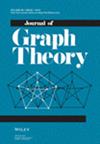Polynomial bounds for chromatic number VIII. Excluding a path and a complete multipartite graph
IF 1
3区 数学
Q2 MATHEMATICS
引用次数: 0
Abstract
We prove that for every path , and every integer , there is a polynomial such that every graph with chromatic number greater than either contains as an induced subgraph, or contains as a subgraph the complete -partite graph with parts of cardinality . For and general this is a classical theorem of Gyárfás, and for and general this is a theorem of Bonamy et al.
色度数的多项式边界 VIII.排除路径和完整多方图
我们证明,对于每一条路径 ,以及每一个整数 ,都存在一个多项式,使得每一个色度数大于 的图要么包含一个诱导子图,要么包含一个子图,即具有心率为 的部分的完整-部分图。对于 和 一般,这是 Gyárfás 的经典定理;对于 和 一般,这是 Bonamy 等人的定理。
本文章由计算机程序翻译,如有差异,请以英文原文为准。
求助全文
约1分钟内获得全文
求助全文
来源期刊

Journal of Graph Theory
数学-数学
CiteScore
1.60
自引率
22.20%
发文量
130
审稿时长
6-12 weeks
期刊介绍:
The Journal of Graph Theory is devoted to a variety of topics in graph theory, such as structural results about graphs, graph algorithms with theoretical emphasis, and discrete optimization on graphs. The scope of the journal also includes related areas in combinatorics and the interaction of graph theory with other mathematical sciences.
A subscription to the Journal of Graph Theory includes a subscription to the Journal of Combinatorial Designs .
 求助内容:
求助内容: 应助结果提醒方式:
应助结果提醒方式:


